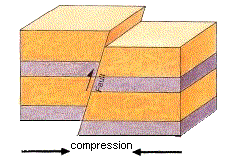|
Landforms are features that make up the Earth's surface. Landforms are
created by the action of wind, water, and ice. This action physically
changes the Earth's surface by carving and eroding land surfaces. Crustal
movement and other tectonic activity inside Earth also create landforms,
like, mountains, faults and volcanos. And these landforms are usually
caused by folding and faulting.
FOLDING
A fold is a bend in rock strata.
It is cased by compression. The powerful compressional forces move towards
each other from opposite directions, contorting and folding the rock layers.
There are different types of folds, the symmetrical fold, the asymmetrical
fold and lastly, the overfold.
 The
symmetrical fold has limbs
of the same steepness. It is formed when the compressional forces pushing
towards each other are of the same strength. The
symmetrical fold has limbs
of the same steepness. It is formed when the compressional forces pushing
towards each other are of the same strength.
 The
asymmetrical fold
has uneven limbs, with one limb steeper than the other. It is formed when
there isa large force from one direction. The
asymmetrical fold
has uneven limbs, with one limb steeper than the other. It is formed when
there isa large force from one direction.
 The
overfold is caused by
the comressional force from one direction, which is so great that both
limbs are sloping in the same direction. When one limb has been pushed
right over the other limb untill the axis of the fold is almost horizontal,
another type of special fold is formed. The recumbent fold. The
overfold is caused by
the comressional force from one direction, which is so great that both
limbs are sloping in the same direction. When one limb has been pushed
right over the other limb untill the axis of the fold is almost horizontal,
another type of special fold is formed. The recumbent fold.
A landform caused by folding the famous Himalayan Fold Mountains which
is formed by compression as two continental masses collide with each other.
As the two land masses came together, both continental plates tried to
subduct beneath each other but because both land masses are made of the
same relatively lightweight rocks, there is no subduction. Their edges
and the sediments between them were buckled and folded. Immense folding
resulted in the formation of the Himalayan Mountains.
FAULTING
A fault is a break or fracture
in the rocks along which the rocks are displayed relative to each other.
This process is called faulting and is caused by the stresses and the
strains in the rocks as the plates move in response to the convection
currents in the mantle. The surface where the rocks have been displaced
is called the fault plane.
 A
normal fault is caused by tension. It forms when there is divergent plate
movement. There is a vertical or nearly vertical displacement of rocks
as one block is lowered relative to the adjacent block. This fault forms
a steep fault scarp which ranges from a few metres to a few hundred metres
in height. A
normal fault is caused by tension. It forms when there is divergent plate
movement. There is a vertical or nearly vertical displacement of rocks
as one block is lowered relative to the adjacent block. This fault forms
a steep fault scarp which ranges from a few metres to a few hundred metres
in height.
 A
reverse fault is caused by compression. There is displacement of rocks
as one block rises relative tothe adjacent block to form an overhanging
escarpment which may be eroded over a long period of time. The Andes is
formed in this way. A
reverse fault is caused by compression. There is displacement of rocks
as one block rises relative tothe adjacent block to form an overhanging
escarpment which may be eroded over a long period of time. The Andes is
formed in this way.
 A
tear fault is caused when adjacent blocks of rocks slide past each other
horizontally along a fracture. The San Andreas Fault along California,
USA, is a transform fault. A
tear fault is caused when adjacent blocks of rocks slide past each other
horizontally along a fracture. The San Andreas Fault along California,
USA, is a transform fault.
An example of landform formed from faulting is Grand
Teton Range in Wyoming, USA. Grand Teton Range is a block mountain
that has an uplifted block and steep fault scarps. It's formed by either
when a block of crust is uplifted or when it is left standing above surrounding
areas that have sunk. If the surface is a horizontal, the block mountain
is known as a horst. A horst is characterised by two pronounced scarps.
The is one such example will be the Black Forest in Germany.
|
